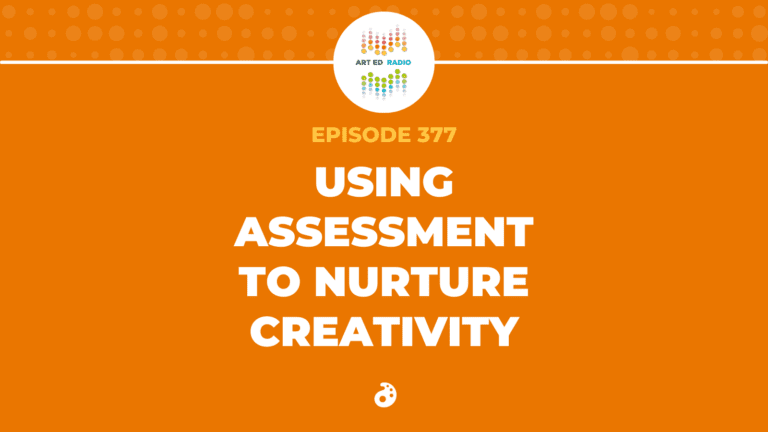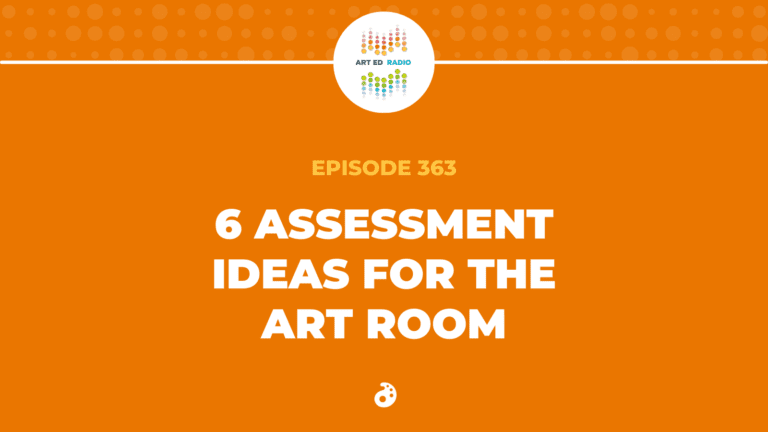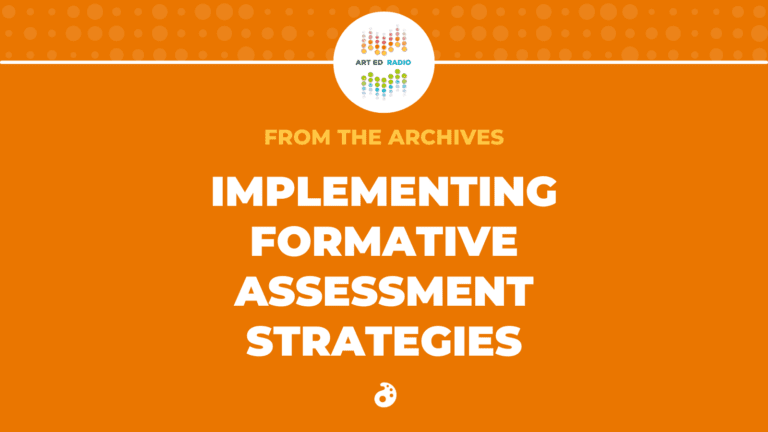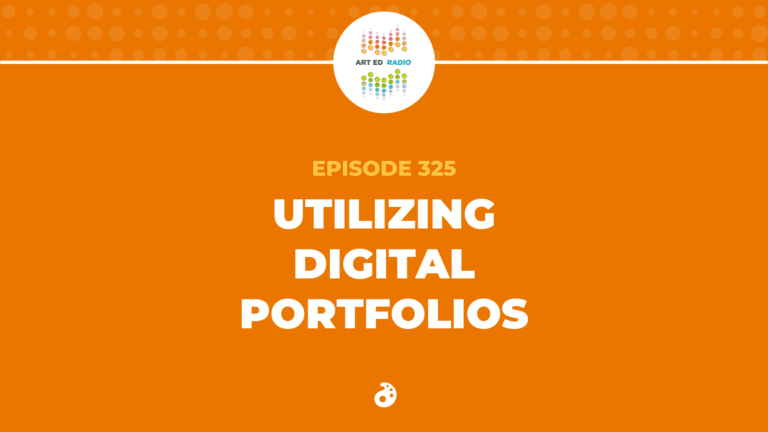Ryan Loeppky is back for another appearance on Art Ed Radio. Back in October, he and Tim talked about all of the amazing things you can do to build your program. Today, the guys have another wide-ranging discussion about how we need to consistently improve as teachers. Listen as they talk about ideas for differentiation (3:15), what we lose when we focus on deadlines (10:00), and why portfolios are such an effective teaching tool (16:45). Full episode transcript below.
Resources and Links
- Follow Ryan on Twitter
- And check out his website
- A great article on building community and culture
- Here is Ryan’s previous podcast appearance
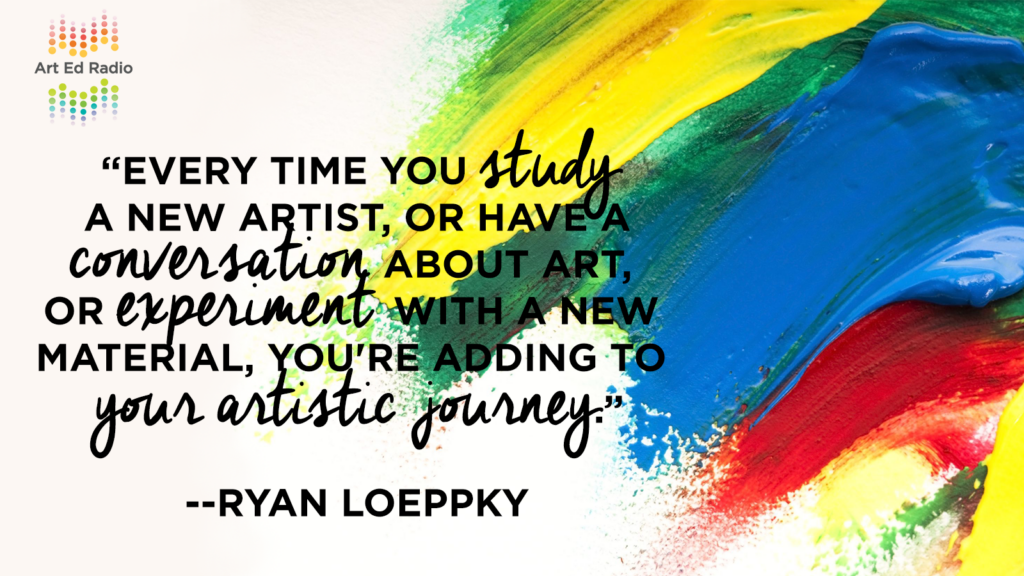
Transcript
Welcome to Art Ed Radio. The podcast for art teachers. This show is produced by The Art of Education and I am your host, Tim Bogatz.
So, back in October I had an awesome guest on named Ryan Loeppky. He is a really cool secondary teacher from outside of Winnipeg and we had a really wide-ranging chat. And what I loved about the conversation was that neither one of us really had all the answers. Now, don’t get me wrong. Ryan is an amazing teacher and he shared so many great things that he’s doing in his classroom.
We talked a lot about classroom culture, how we want our students to develop, you know, what we want them to learn and know how to do. And Ryan brought up the idea of the artful human, as he calls it and it’s a concept that I love. You know, it’s an idea that’s all about how we bring creativity, and problems solving skills, and resilience to everything that we do. You know, whatever job you’re doing, it can have creativity involved with it.
And so, this idea of the artful human is for everyone. You know, each one of our students who comes through our doors. Everyone is contributing and being an artful human in their lives. It’s a great idea and it’s a great way to run your classroom, but like any good teacher, Ryan has continued to question himself and continue to evolve. He and I have kept touch off and on and he’s asking some big questions about what he’s doing in the classroom. Am I teaching process the right way? How should that affect my kids? How does it affect their art product? And most importantly, you know, he’s asking what can I be doing better and how can I do it?
And I really appreciate the fact that he’s taking such a critical lens and putting it on his own teaching. As we talk about all the time, reflection is such a big key when we want to improve as teachers. It’s so important to think about what you’re doing, question what you’re doing, and constantly be on that path to getting better at everything that we do in our classrooms.
So, today we’re going to kind of continue that discussion. And you know, to be honest, I don’t know exactly where it’s going to go and I kind of love that. But, I want to see where Ryan is right now, how his thinking has evolved over the past five or six months, and I want to see what he’s thinking about and what he’s doing in his classroom right now. So, let me get him on the line and we will see where this conversation goes.
Tim: Ryan, great to have you back on the show. How are you?
Ryan: Good. It’s good to be back now.
Tim: All right, cool. Well, I am excited to chat with you about all of these, I don’t know, I guess we can call them big ideas. So, I guess if we’re just kind of diving in and kind of thinking about the big picture of what you like to do in your classroom. I know you’re a big fan of differentiation, letting kids work at their own pace, and you know we discussed all that last time that you’re on the podcast, but can you just talk a little bit about your approach to teaching? I mean, I guess that’s kind of a really big picture thing, but talking about, you know, how you handle having so many different students all finishing their work at different times.
Ryan: Okay. Well, first I’m prefacing this whole thing with like these are ideas, this is what I struggle with, this is what I think about on my 40-minute drive to school, and 40-minute drive back home every day. I tackle these things so, I hope your listeners are open to hearing these ideas and seeing how they might work, and maybe they just think I’m totally off my rocker, which is cool too. So, yeah. I’m going to go with that first, so.
Tim: Okay.
Ryan: Yeah, yeah, my big thing right now and I talked about it on the last podcast about being this artful human, that it applies to anyone that takes art in, that starts to create art in their own life, and bring in creativity. And thinking about how we problem solve and how we build resiliency and all of this, but we have such a diverse group of people. A diverse group of students, whether they’re young, or whether they’re in high school. I’m a high school teacher.
And I keep telling these students, it’s crazy how we have this idea of a curriculum and how everyone needs to get over this finish line. Like, whatever this finish line is, these standards that we have for all these students, and you got 80% this time, and 90% that time, or whatever. We’re all trying to get all of these diverse students over the same finish line and I go, that’s bonkers to me. And we’ve been doing it over and over for years and years and years and years. And finally, I just said to myself, “I can’t be doing this to my students anymore.”
I’ve got a kid that has just come in learning drawing for the first time, and I’ve got this kid that’s been making other kids hate him because like he draws cover pages really well since he was six-years-old, you know?
Tim: Yeah.
Ryan: And you have such a diverse group and I go, “What if I just gave them all their own finish line?” And what I mean by finish line is a start and a finish in an artistic journey. And so, I started to think about that more and I said, “Is it possible to do? Can I do this?” And there are days when I think I can and days when I think I can’t. So, I guess my big idea is everyone has their own artistic journey in my class.
Tim: Yeah, I like that. And so, let me ask you though, like how does that fit with your approach to curriculum? Like, how do you get kids through particular projects? How do you deal with deadlines? Like, for me, you know I’m never saying, you know, “You guys need to be done with this on Friday.” But, you know, I’ll just tell them, “Hey, next week we’re moving on to our next project. You know, we’ll get everybody involved with that. If you still need to finish what you’re working on, or you have ideas you still want to explore, that’s cool, but you’re on your own.” Like, what does that look like in your classroom?
Ryan: That’s exactly what I say too, and I really like that. I say you know, “We can’t just like hang on to this one thing forever.” I try to talk to my students a couple of different ways. The first thing to say is, “I’m going to introduce you to something.” And I’m trying not to say assignments anymore, man. I don’t know why, but maybe it’s like my experience in school, but assignment, like it’s the A word. You know? And I’m like, oh, I don’t know if like this, right?
Tim: Yeah.
Ryan: So, instead of saying assignment, I say challenge. Right? Like this is our new challenge. We’re looking at … let’s say it’s grade nine. It’s the first year of art in high school with me and I say, “One of our first challenges is, we got to let our eyes tell our hands what to draw instead of our minds. Like, get past drawing discs with sticks out of them, coming out of them and calling them a sun.” Or, you know, there’s so many examples. I can’t think of any right now, but our mind kind of takes over.
So, one of our challenges is we got to build up some observation skills. So, let’s start to train our eyes to tell our hands what to do. So, I’m trying to get them into doing more challenges, than here’s an assignment and here’s when it needs to be done. And I think it’s an ongoing thing, so I say, “Let’s explore this for seven … or let’s explore this for a week. Then, let’s go and talk as a group because we’re a class. We’re a crew.” Right? Like, I call them my art family when we get in. We’re a family now.
And I tell them, “Okay, so let’s look at this for a week. And then lets re-explore this after and see how it goes. Like, maybe we need another week to explore this challenge, but then we will need to move on. There’s other things I want to share with you guys, and then obviously you’re going to have some extra time throughout the year that you’ll be able to come back and explore that stuff.” I don’t know if that made any sense, Tim, but.
Tim: No, I think that makes a lot of sense, and I think it gives everybody something to think about as, you know, how you approach your assignments or if you don’t want to call them assignments, how you approach your challenges.
Ryan: Yeah.
Tim: That actually kind of leads me into my next question here is, you know, I assume that if you’re taking that approach then you’re very much toward the process side of the great process, versus, product debate. So, you know, like I guess what does that debate look like for you, whether it’s in your classroom or just in your own head as you’re driving to and from school every day? Like, what does process, versus, product look like for you?
Ryan: Oh man, I could talk forever … like man, you got to come … I invite you to come into my carpool for like one day. You come and drive with me, and we will talk for 40 minutes and then we will look forward to the next 40 and then you’ll be like, “I can’t talk to this guy anymore. Like, it’s too much.” But, the whole process and product debate is like this is my epic battle. I think this might be the hill I die on. I’m not quite sure, because and here’s the reason, we have the rest of our lives to have deadlines, and we have the rest of our lives to have … well, for most of us have somebody, you know, looking over our shoulder going, “Are you done that? Are you finished that? When’s that done? When’s … ” you know what I mean?
So, we have this beautiful time in our lives. These students have this beautiful time in their lives where maybe they have a little bit of freedom. Maybe they have some freedom to just start to experiment and open it up a little bit. So, this is … now, I get into my whole process, versus, product debate and that is, one of the things I tell my students at the beginning of the year is I roll out a piece of tape, a big long piece of tape.
And I go “This is your artistic journey. This is you as an artful human and this is your journey in my class. Every time you fail, and you crunch it up and you throw into the waste bin, you’re taking like a chunk of that tape off. And every time that you study a new artist, or you talk to somebody in your class, or you sketch something that you never have done before, or you research something, or you have a conversation with me, or you take a picture of the graffiti that you saw in the city, you’re adding to that tape. You’re adding all these beautiful things. And yes, we have our challenges that we do. Like, I challenge you to do these things, but the end product is like a snapshot of this gorgeous journey, but it’s not the end all be all. It’s not the … it’s great, it’s beautiful, it’s all … it’s a culmination of it.”
But, the journey is where we see the learning. The journey is where we foster a relationship with these students. The journey is where they foster relationships with other people in the art family. It’s where they grow as an artful human. It’s where they start to think. It’s where they start to grow in their hearts and they’re minds. Man, the journey is the learning. I think the product is great and it’s a good celebration, but we need to start celebrating that journey. That would be my … that would be the 40 minute … that’s a crammed 40 minutes, man.
Tim: No, I love how you think about that. I love the example with the piece of tape. I think that’s really kind of putting into perspective for kids. You know, everything that you want them to do. But, you know, with that being said, you know, I kind of want to get your take on assessment as well. Like, if we’re spending all of this time encouraging kids to develop this journey, to explore, to do all of these things, you know, outside of the classroom, and you know, I know because of that you’re not a huge fan of grades. And I know we’ve talked about the idea of, you know, who are those marks or those grades really for? So, can you just expand I guess on your thinking when it comes to assessments?
Ryan: Yeah. I hope the secret service, or I think it’s the … oh, what is ours in Canada? I forget what they’re called. I hope they’re not listening in when I start talking about not liking not grades too much. But, I don’t know. Okay. So, the idea of grades. I think the big question is who are the grades for? And I know you mentioned that in the question and it’s something that I really think about. Am I appeasing the data gods by creating these grades? Are they for … are these grades for the students with really extrinsic reward-based students where they’re like, “I’m here for the grade Loeppky, just tell me what I need to do to do it.” Right? And obviously, I’m very disappointing when I say, “Well, you should be creative. You should think outside the box and you should fail all the time.” And these extrinsic reward people are going, “Oh, no. What do I do?” Right?
Tim: Right.
Ryan: “He’s going to make me think.” I won’t just be able to memorize something, or I won’t be able to you know, I don’t know, read the Cole’s notes on it, or something like that. So, I guess I have a challenge for all teachers and the challenge is I want you to sit down and look at your grades and look at those numbers, and ask yourself, “Who is this for?” Is this grade for the student? Is this eight and a half out of ten for a student when they see it? Is it for you to feel like okay, you’re doing the right thing here.
Or, is this a … I don’t know if I’m allowed to swear on these podcasts, so I’m going to say I call it a CMA file, but I’ll call it a CMB file, which is a cover my butt file. And that is, is all of this data and all of these numbers to just cover my butt in case, you know, I have to talk to a parent about Johnny getting a 95 instead of a 100. Right? Is it for administration?
What is this number for? And then I say to myself, “What does assessment look like if it was just for the student?” Is it a conversation with them? Is it a pat on the back going, “Really great creative work.”? Is it asking questions, relevant questions to that student? Is it lifting them up and going, “Wow, you really thought about this in a fantastic way that I’ve never thought of before. Thanks for helping me learn.”? Is it giving feedback in better ways than, you know, maybe … even rubrics kind of drive me crazy, but I know I’m supposed to and it’s like, ah. It’s all just so … I struggle so much, Tim. Help me.
Tim: Well, I wanted to ask you though, you know, do you think this is somewhere where like a student portfolio can come into play? Like, you know, for me, I love portfolio’s because it’s sort of the representation of this ongoing journey where you can talk to kids about improvement.
Ryan: Yeah.
Tim: You can show them how they’re growing, seeing where they might want to go in the future.
Ryan: Yeah.
Tim: And at the same time, you can use that for grades, for you know, all of the requirements we have on us as teachers to play that school game and do the assessments that we’re supposed to do. So, is that something that’s a possibility? Is that something that you do? Like, you think that portfolios have a role when it comes to assessment, and student growth, and the process, and everything that you’re talking about here?
Ryan: Yeah, you know what? And that’s something that probably about five, six years ago, I started playing around with the idea of who’s telling who what they’ve learned? Is it me telling the students what they’ve learned, or should the students be telling me what they’ve learned? And I’ve started to think, man, like yeah, I know what you’ve learned because I’ve been doing this a long time. Like, this isn’t my first rodeo. So, I know what you’re learning, but do you know what you’re learning?
And that’s where this portfolio came in. And I know that traditional portfolio is get your stuff, throw it some clear plastic, you know plastic pages or whatever, and then you have like a physical portfolio. But, I thought maybe there’s something that could kind of connect technology with sort of an Instagram, instalife kind of thing. And then the online portfolio seemed like a really good way of doing that.
And so, there’s a Canadian company here called Sesame Snap, who does an online portfolio. And there’s a really good one that we’re using right now in the United States called Seesaw. And it’s an online portfolio. I know I’m not supposed to advertise stuff but, it is a good portfolio program. Basically, what it is, is students get a chance, whether with their iPod, or their iPad, iPhone, their Android device, or whatever, or I’ll give them my own device, they get a chance to photograph their work and put it on their online portfolio.
They start to take control of their artistic journey, and they start to create this timeline of their journey. And I think it’s really about empowering them to take control of their own learning. That doesn’t mean that I’m not responsible for a lot of stuff, but I think the more control they take over it, the more pride they feel, and I think the more intrinsic reward they get out of it.
So, I’m a huge fan of online portfolio’s. It gives students, especially the introverts, a chance to talk when maybe they don’t like talking to me too much, or we’re in a very public place, so there they get to do it. They show me so much stuff that’s outside of like class and I’m like, that’s what art is about. It’s not necessarily the one hour that’s in class, it’s the creative stuff you’re going to do outside of class.
So, like I was saying before they, they might take pictures of graffiti on a wall, or they might go to a gallery, or be like, “These piece of garbage on the ground looks really cool.” And they’ll post that on there. They’ll post music that they really like. They start to show me the artful human, right? Instead of just you know, “I did this project. Here it is. I hope this appeases the project gods.” Right?
And then so my assessment comes from that. So, I look at their artistic journey. I know that your American standards, they are … what are they again. You’ve got creating, presenting, responding, and connecting.
Tim: Correct.
Ryan: As your national … so, Manitoba has making, creating, connecting, and responding. I’m sort of the gatekeeper when it comes to all of the wordy stuff that comes from the curriculum, right? I’m sort of the gatekeeper of all that. So, I actually boil it down for my students to head, hand, and heart. Head being conceptualization, getting ideas, sharing ideas, talking with people, looking at art history, and all of that.
Hand is the technical skill, right? So, whatever’s in my head, whatever I’m imagining, whatever I’m dreaming of, how can I get that out? And it comes out through my hands, or it comes out through creating. And then the heart is the part where they’re invested in the work that they’re doing. That they’re actually genuinely interested in the piece that they’re doing.
And so, I break it down into those three and it’s a lot of conversation with my students. It’s a lot of saying, “Hey, this shows a lot of technical skill. Good job on getting like your hand mark for this challenge.” And so on.
Tim: Yeah, I think that’s really pretty poignant. I think the yeah, the head, the hand, and the heart. I think that’s a great way to kind of put everything together for kids and put it into a way they really understand. And I think that’s actually a really good place for us to leave it.
Ryan: Yeah.
Tim: So, Ryan, thank you very much for joining me. It was good to talk to you again and hopefully we can have you on again soon.
Ryan: Yeah, for sure man. Absolutely. Can I say one more thing before we’re done?
Tim: Absolutely. The floor is yours.
Ryan: Okay. I just want to say … just a message for all of you art teachers out there. However many columns you have in your grade section of whatever grade book you’re using, whether it’s an excel file, does not define you or define how good of an art teacher you are. Make those relationships. Make those connections with those students, and just foster the beautiful people that they are.
Tim: Very nice. Very nice. Very well said. Thank you, Ryan.
Ryan: Yeah, anytime.
Tim: All right, let’s wrap this up now. Like I said, I didn’t know where that conversation was going to go, but I really enjoyed it. It had a little bit of everything, assessment, and process, and product, and growth, and some awesome ideas for differentiation. So, I really enjoyed checking in with Ryan, and I hope you enjoyed the conversation as well.
Now, before we go, I wanted to talk to you about Art Ed PRO because I think it’s such a good fit with some of the themes that we’re talking about today. You know, if you are questioning, and reflecting, and looking to get consistently better as a teacher, Art Ed PRO is what you need. The library is filled with on-demand video tutorials, downloadable handouts, and all kinds of other just amazing resources that really can help you learn new things, and help you take your teaching to the next level.
And three new learning packs came out last week. There’s one on integrating art and science. One on mosaics and the one about evaluations that we talked about Amanda Heyn, last week on this show. So, the pro-library now has 60 learning packs, which should cover just about everything you need when it comes to teaching art. And if you haven’t tried it, you can get at 30-day trial for free and you can see how amazing it is. So, give it a try: theartofed.com/pro
Now, I like how Ryan said at the end there, the number of grades in your grade book, and the number of required assessments you have to do does not define who you are as a teacher. It’s about relationships, it’s about connections, and it’s about meeting our kids where they are. So, no matter how much you have to worry about outside influences, or someone looking over your shoulder, or even those doubts you put on yourself as you’re in the middle of that cycle of questioning, and reflection, and growth, you can’t forget the biggest thing, it’s all about our kids.
Art Ed Radio is produced by The Art of Education with audio engineering from Michael Crocker. Remember you can sign up for our email list at artedradio.com because doesn’t everybody want to get exciting emails from me every week? They’re quick. They’re entertaining, complete with hilarious GIF’s and most importantly, they remind you to come listen to an amazing podcast.
And if you’re lucky, I might just throw in some links to some of my favorite art-related stuff from the past week. So, give it a try. Sign up at artedradio.com and we will talk to you next week. Thank you for listening.
Magazine articles and podcasts are opinions of professional education contributors and do not necessarily represent the position of the Art of Education University (AOEU) or its academic offerings. Contributors use terms in the way they are most often talked about in the scope of their educational experiences.
